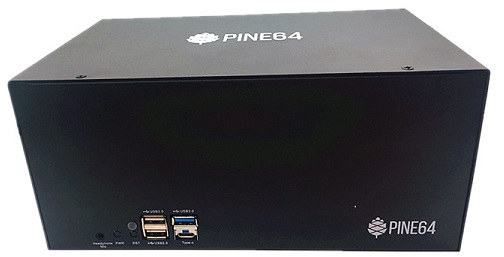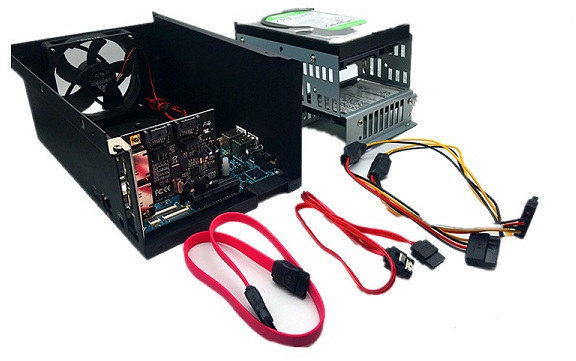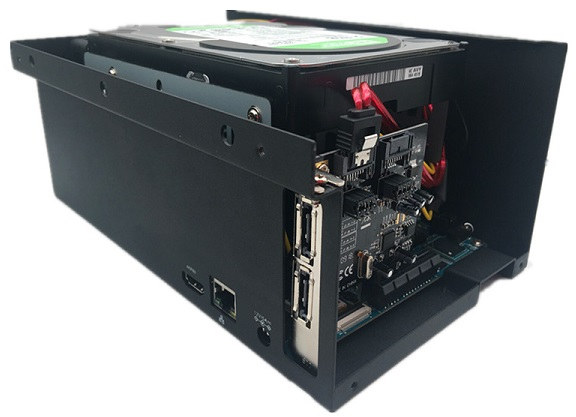ROCKPro64 is one of the most affordable Rockchip RK3399 boards, as you can purchase it for as low as $60 with 2GB RAM, and $80 with 4GB RAM. Pine64 – the company behind the board – also offers add-on boards such as a PCIe card to connect up to two SATA drives.
The company has now leveraged the latter in their ROCKPro64 metal desktop/NAS casing specifically designed for ROCKPro64 boards, and capable of holding two 2.5″/3.5″ SATA drives. Key features of ROCKPro64 Desktop/NAS case:
Key features of ROCKPro64 Desktop/NAS case:
- Compatible with ROCKPro64 boards only
- SATA – Accommodates either 2x 2.5″ SATA drives or 2x 3.5″ SATA drives or a mix of 2x 2.5″/3.5″ SATA drives
- Power Supply – 12V DC
- Dimensions – 232.4mm (Width) x 105.0mm (Height) x 145.2mm (Depth)
The case also ships with 2 SATA data cables, and a custom designed power supply cable as shown below.
 However, the company also notes that ROCKPro64 SBC, heatsink, fan, and PCIe SATA adapter are not included. I understand about the ROCKPro64 and heatsink and/or fan for the board not being included, but you’ll have to remember to add the PCIe to 2x SATA adapter to your order, and possibly a standard 80cm fan by yourself [Update about the fan: Pine64 decide not to include it by default because some users prefer low speed and low noise, while other prefers to have higher speed for better ventilation, and it will also depend on the type of HDD fitted to the case].
However, the company also notes that ROCKPro64 SBC, heatsink, fan, and PCIe SATA adapter are not included. I understand about the ROCKPro64 and heatsink and/or fan for the board not being included, but you’ll have to remember to add the PCIe to 2x SATA adapter to your order, and possibly a standard 80cm fan by yourself [Update about the fan: Pine64 decide not to include it by default because some users prefer low speed and low noise, while other prefers to have higher speed for better ventilation, and it will also depend on the type of HDD fitted to the case].
Software-wise, you’ll find Debian based OMV (OpenMediaVault) and Ubuntu 18.04 images for ROCKPro64 on Github. Note the link points to 0.7.4 images that are currently tagged “pre-release”, and in most cases, should not considered as stable as their “release” images. But I’ve been informed the 0.7.4 images should soon be set to “release”.
 If you want to go ahead, you can purchase the enclosure for $44.99, the PCIe to 2x card for $9.99 on Pine64 store, and optionally a $12.99 12V/5V power supply. So a complete NAS kit with a 2GB RAM ROCKPro64 board and all cables – not including the hard drives – should cost around $128 plus shipping. Hopefully, Pine64 will come up with a “NAS Kit” where everything – minus the RK3399 board and drives – is included to make ordering a bit easier.
If you want to go ahead, you can purchase the enclosure for $44.99, the PCIe to 2x card for $9.99 on Pine64 store, and optionally a $12.99 12V/5V power supply. So a complete NAS kit with a 2GB RAM ROCKPro64 board and all cables – not including the hard drives – should cost around $128 plus shipping. Hopefully, Pine64 will come up with a “NAS Kit” where everything – minus the RK3399 board and drives – is included to make ordering a bit easier.
Thanks to tkaiser for the tip, and lucasz for extra info provided on IRC.

Jean-Luc started CNX Software in 2010 as a part-time endeavor, before quitting his job as a software engineering manager, and starting to write daily news, and reviews full time later in 2011.
Support CNX Software! Donate via cryptocurrencies, become a Patron on Patreon, or purchase goods on Amazon or Aliexpress




